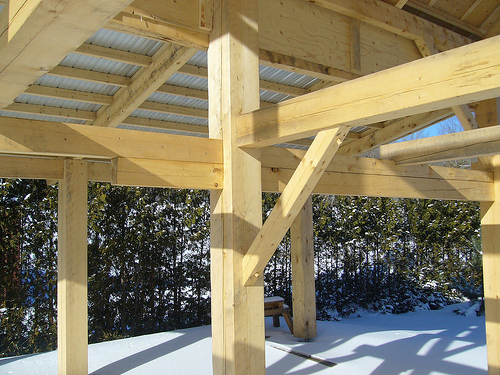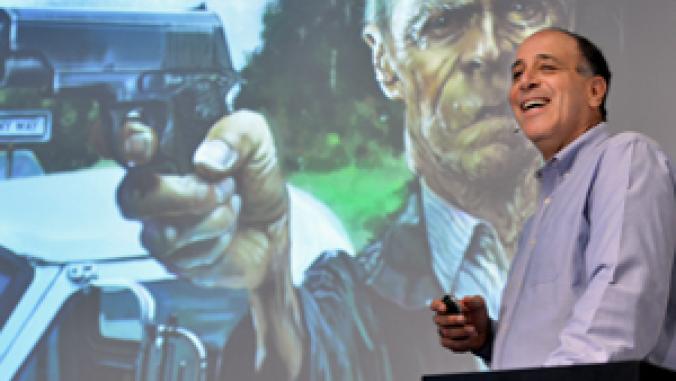USGBC Wood Policy Stands (for Now) After Battle Over Eco-Labels
<p>After a lengthy and contentious review, members of the U.S. Green Building Council -- the organization behind the LEED rating system -- rejected a proposal that would have opened the door to wood certified under various eco-labels to be considered for LEED credit. But the issue remains alive even though the latest battle is over.<br /> </p>

After a lengthy and contentious review, members of the U.S. Green Building Council -- the organization behind the LEED rating system -- rejected a proposal that would have opened the door to wood certified under various eco-labels to be considered for LEED credit.
While the status quo has not changed -- only products certified by the Forest Stewardship Council are recognized under the rating system -- don't expect the issue over LEED credit for wood products to fade away:
- The FSC and Sustainable Forestry Initiative, the chief FSC rival among certifying groups that supported the failed attempt to change rating system rules, want to revisit the issue for different reasons.
- Development of the consensus-based Leadership in Energy and Environmental Design rating system is ongoing, and the USGBC recently released the draft for the next version of LEED and opened public comment on prospective changes. Expect another attempt to update the wood credit during this process.
- And apart from the rating system, emerging green buildings codes and standards such as ASHRAE 189.1 and the International Green Construction Code v 2.0 are framed so that certified wood products bearing various eco-labels are recognized as long as the products meet benchmarks cited by the standards. The situation could result in greater use of wood certified under a range of labels, in spite of the long-running dispute over LEED wood credit.
On Monday, the USGBC announced the outcome of balloting on the proposal to change the wood credit rule, which required a two-thirds majority for approval. Fifty-five percent voted in favor, 42 percent opposed it and 3 percent abstained. GreenerBuildings.com Executive Editor Rob Watson writes in his column this week:
“Ironically, a coalition of people who felt that the credit went too far joined with those who felt it did not go far enough to kill the initiative ... I always knew that this would be a tough issue to address and my hat is off to USGBC for not caving to interests on both sides.”
The dispute traces its roots to more than a decade ago when the LEED standard was first developed. At the time, the Forest Stewardship Council’s certification process was deemed the most mature -- and most independent -- system available, and it became the only eco-label for wood accepted by the standard.
That decision formed the basis for a controversy that percolated for several years before erupting into a full bore war of words among competing certification labels, their advocates, those who believe the LEED wood policy is too restrictive and should be based on benchmarks not specific labels, and still others who hold that the wood credit rule doesn’t go far enough and needs to be fine tuned.
Efforts to sway USGBC members included a petition and letter writing campaigns that included scores of lawmakers, environmentalists, industry groups and NGOs aligning with various interests.
Just last month, ForestEthics released a report that decried the Sustainable Forestry Initiative as a greenwasher and said the organization remains a creature of the timber industry. SFI, which points to its breakaway from the American Forest & Paper Association in 2007, countered with a “setting the record straight” rejoinder to refute the allegations.
While the USGBC has dealt with contentious issues over the years none has approached the intensity of the battle over LEED credit for wood, Brendan Owens, the USGBC’s vice president for LEED Technical Development said in an interview with GreenBiz.
Scot Horst, the USGBC’s senior vice president for LEED, acknowledged the controversy in his announcement of ballot results to organization members:
“Over the past six years, this one point in the 100-point rating system has continued to be the source of tremendous tension for USGBC members and industry professionals alike. When the rating system was first adopted by the membership, it included a single point for FSC-certified wood as way to set a bar for better forestry management. As other certification systems have improved their practice, they have been pushing hard for their certification systems to be recognized in LEED.
“In 2006, the USGBC Board of Directors asked the volunteer Materials & Resources Technical Advisory Group (MR TAG) in conjunction with the LEED Steering Committee to study the issue and propose a way forward. The result was a clear and transparent benchmark that was designed to afford all forest products certification programs an equal ability to demonstrate leadership and earn recognition in LEED. The USGBC Forest Certification Benchmark would have allowed any forest certification programs to be objectively evaluated against the same comprehensive set of stringent attributes. Programs that met the benchmark would have been recognized in LEED and programs deemed non-compliant would have had a clear understanding of what changes would have been necessary to receive recognition in LEED ... “
The organization will use the information and commentary that flooded in on the wood issue to inform its work on the next generation of LEED, said Owens, who urged the public to offer ideas on shaping the new version of the standard.
While there are different avenues to revisit the wood issue, “it’s too early to tell whether there will be further work on forest certification,” he said. “It’ll be on the table, but it won’t be the only thing on the table.”
At FSC, President Corey Brinkema issued an open letter yesterday saying, “FSC strongly encourages USGBC not to give up on the benchmark process, but rather consider quickly turning around a revised ballot. Based on the results of the recent vote, we are confident a strengthened benchmark would be approved by the membership. Closing a few unintended loopholes and giving prerequisite status to several optional credits within the current benchmark would likely garner the support of the U.S. conservation community and building industry professionals who recently voted “NO” in order to keep the LEED standard for forests high.”
In a statement for SFI, President and CEO Kathy Abusow characterized the results of the recent LEED rules vote as a “new opportunity to work with the USGBC and other interests to find an alternative and workable solution moving forward, one that works for USGBC’s members and at the same time recognizes the benefits of wood in green building and the proof point offered by forest certification.”
“SFI is willing to work with USGBC and other stakeholders ... and willing to work in any avenue and any direction that the USGBC outlines,” SFI spokesman Jason Metnick added.
ForestEthics doesn’t consider its work on the issue is over either, said Executive Director Todd Paglia. “There’s a lot of chapters still to go in this book,” said Paglia, whose organization holds firm to its view of SFI.
Jim Bowyer, the director of the Responsible Materials Program at Dovetail Partners Inc. and president of his own wood science and bioenergy consulting firm, said he’s doubtful that consensus will be reached any time soon on the LEED wood credit front because “the divisions are so deep and the entrenchments as such” are so strongly held among stakeholders.
“To some extent, the vote could be a moot point,” Bowyer said, pointing to the way the CalGreen Code, which soon takes effect, and drafts for ASHRAE 189.1 and the International Green Construction Code v 2.0 address wood certifications.
In fact, he said, Dovetail considers that “the time is long is overdue that LEED and other green building programs require that all building materials have some sort of certification. It’s an issue that we’re pushing.”
Image CC licensed by Flickr user ARBRE ÉVOLUTION.





